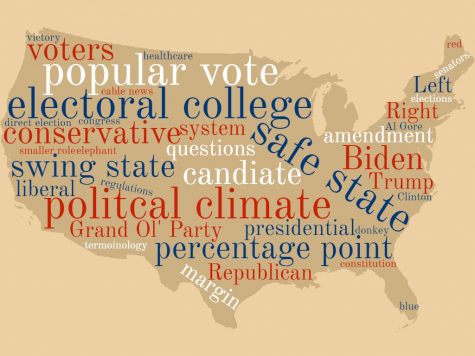Key Vocabulary for Understanding US Politics and Elections

Politics can be extremely complicated, especially in the US, and trying to understand politics can be difficult due to all the complex terminology used. Here is some of that vocabulary, defined in a straight-forward fashion.
Electoral College:
The system of electing the president. 538 electoral votes are divided up among the 50 states and Washington DC, and are based on the number of senators and representatives of each state. Every state has two senators and at least one representative, meaning the lowest number of electoral votes a state can have is three. For example, California has 53 representatives, so it gets 55 electoral votes–the most of any state. Conversely, states with small populations such as Delaware or South Dakota only have three electoral votes.
The candidate that wins a majority of electoral votes wins the presidency. Because there are 538 electoral votes, a candidate needs to win at least 270 to win. If each candidate wins 269 electoral votes, then Congress decides who has won the presidency.
Percentage point:
A unit used to measure the size of an election victory. One percentage point equals one percent, so if a candidate wins a state by six percentage points, it means that the winning candidate won 6% more votes than their opponent.
Safe state:
A state that consistently votes for one political party by large margins. Traditionally, a state that consistently votes for one party by around 15 percentage points or more is considered a safe state. However, due to the polarization of the current political climate, a state where one party consistently wins by about 10 percentage points or more could be considered a safe state.
Swing state:
A state that votes for different political parties depending on the election, and typically has smaller margins. Generally, swing states go to the winning candidate by less than 5 percentage points. States that generally go to one party by 5-9.9 percentage points are considered likely–they may occasionally go to the other party, but they usually don’t.
Left/Right:
Typically, left refers to Democrats and right refers to Republicans. However, these terms are more complex. The left traditionally favors more government intervention in the economy and businesses, as well as a greater government role in providing services like public healthcare. The right advocates for a smaller role for the government with fewer regulations. On social issues, however, Republicans are more conservative, while Democrats are more liberal. The democratic party is represented by a donkey and the color blue. The republican party, also called the Grand Ol’ Party (GOP), is represented by an elephant and the color red.
Popular vote:
The popular vote winner is the candidate that wins the most votes. However, as we discussed earlier, in the United States the presidential candidate who wins the popular vote does not necessarily win the presidency. This has only happened five times: Andrew Jackson lost to John Quincy Adams in 1824, Samuel Tilden to Rutherford B. Hayes in 1876, Grover Cleveland to Benjamin Harrison in 1888, Al Gore to George W. Bush in 2000, and Hillary Clinton to Donald Trump in 2016. There have been attempts to replace the electoral college system with a direct election, but none of those attempts have been successful.
So, these are some of the key terms you need to know to figure out what on earth those people on cable news are talking about. Hopefully this has been helpful.
Part 2 coming soon: Analysis of what the 2020 election means for the future of US politics
Your donation will support the student journalists of Wilde Lake High School. Your contribution will allow us to purchase equipment and cover our annual website hosting costs.





